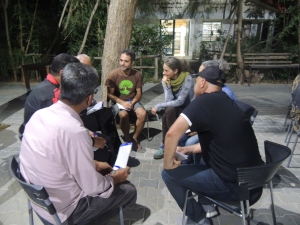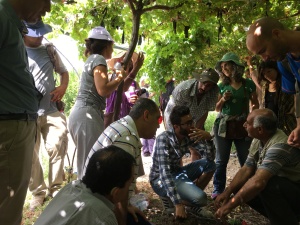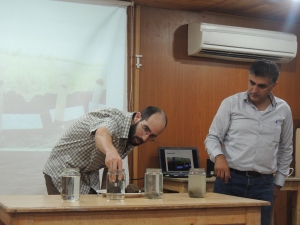
From June 28-30th Jordanian and Israeli farmers met for a cross-border workshop to learn more about biodynamic agriculture and to discuss some of the common challenges facing farmers in the Jordan Valley on both sides of the border. As a new intern for EcoPeace, this was my first time being in the Jordan Valley and it was a far cry from the water abundant fields in my home of Ohio, USA. I was excited to learn more about the environmental challenges specific to this area and to meet new people.
The workshop began with dinner and introductions at the Sharhabil bin Hassneh EcoPark, breaking into small circles of mixed groups which created a personalized atmosphere for the attendees to get to know each other. I really enjoyed seeing the cultural exchange that occurred as the farmers traded jokes and stories with each other in three different languages—Arabic, English, and Hebrew—often jumping between them in the same sentence. Participants also discussed why they chose to take part in the workshop. They included reasons such as to meet people from a different culture that still share the same career and goals, to learn more about biodynamics, and to make new connections that could be used to work together in the future.
The next morning, the group took a site tour of area grape, citrus, pomegranate, and date farms and analyzed the different soil types and irrigation methods at each one. Water was the theme of the morning as farmers yearned to know the most efficient way to get healthy plants for the least amount of expensive water. However, after digging into the dirt at each of the farms, we found that using water and fertilizer on the greater area surrounding the plant was important to its overall health, and skimping too much on water use would ultimately result in harmful effects long-term. The ideal soil would have a high water-holding quality. As a geology student, I appreciated getting our hands dirty and digging into the dirt to check out the health of the soil. It was interesting to visually see how the soil in two farms neighboring each other could significantly differ based on the irrigation methods used by the farmer that contributed to the general health of the soil.
farms and analyzed the different soil types and irrigation methods at each one. Water was the theme of the morning as farmers yearned to know the most efficient way to get healthy plants for the least amount of expensive water. However, after digging into the dirt at each of the farms, we found that using water and fertilizer on the greater area surrounding the plant was important to its overall health, and skimping too much on water use would ultimately result in harmful effects long-term. The ideal soil would have a high water-holding quality. As a geology student, I appreciated getting our hands dirty and digging into the dirt to check out the health of the soil. It was interesting to visually see how the soil in two farms neighboring each other could significantly differ based on the irrigation methods used by the farmer that contributed to the general health of the soil.

Biodynamic agriculture is a holistic approach that seeks to improve the health and output of crops by implementing techniques that work in harmony with the already occurring natural processes. It recognizes the inherent connection between water, nutrients, sunlight and soil to plant health, and how all the parts must work together to be effective. It also stresses the importance of working with the community and buying produce locally on the consumer’s end. This was my first interaction with the idea of biodynamics, but I was able to see the importance of working in harmony with the environment and not “against” it, especially in a climatically harsh area like the Jordan Valley.
Being on-the-ground in these places allowed me to personally observe the intense water scarcity and hear each farmer describe their struggle, which gave me tangible evidence for the environmental issues I had only read about up to that point; it was a chance for me to formally encounter what I had been researching. The farmers participating in the workshop had a lot of knowledge to contribute, and each shared their experiences and farming techniques, and resulted in the farmers learning from each other just as much as they learned from the presenter.

That trip led to a series of informative presentations on biodynamics, where farmers learned more about the concept and generated ideas for implementation. The workshop concluded with small group discussions where participants worked together to come up with solutions for their soil, water, and marketing problems. At the very least, participants gained the realization that many of the problems they faced were happening at a systematic level, and they were not the only one having to deal with it. Joining in on this workshop not only taught me more about biodynamics, but I got a chance to meet so many inspiring people from across the Jordan Valley.
This article contributed by Nicole Pasho, EcoPeace Middle East - Amman.